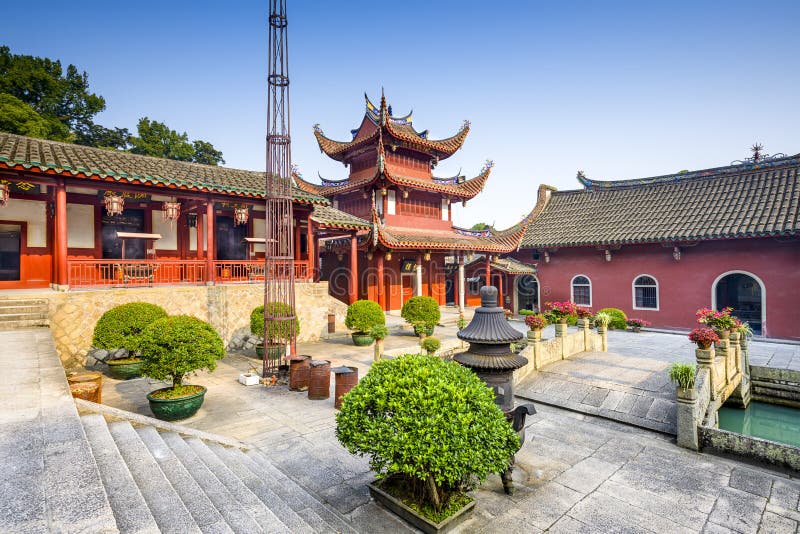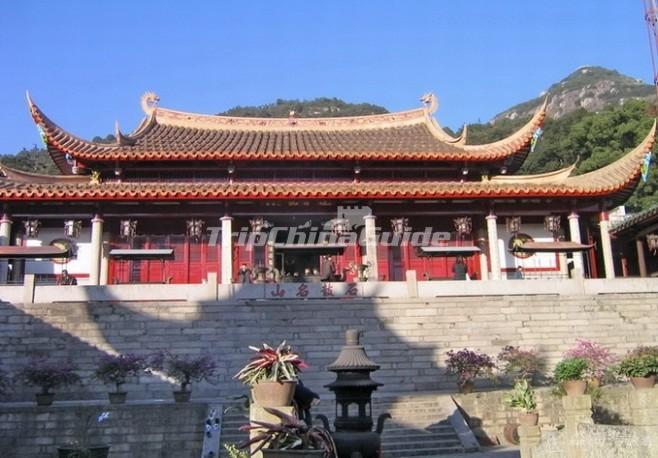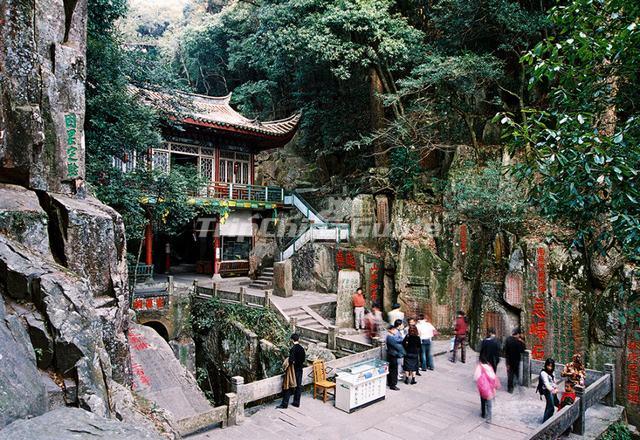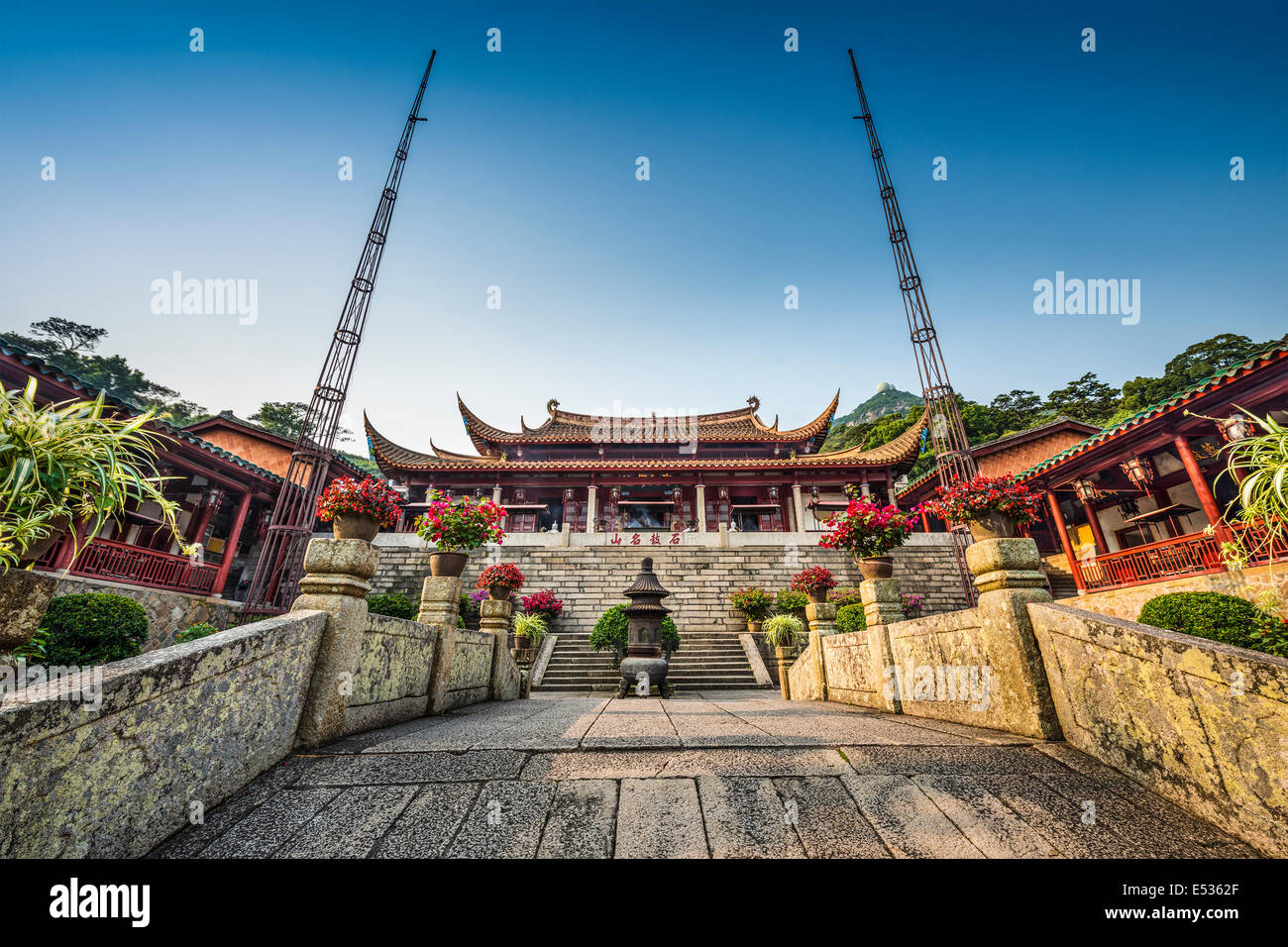Discover the Tranquil Beauty of Yongquan Temple

An Essential Guide to Visiting Yongquan Temple
Tucked away in the serene embrace of Gushan Mountain, Yongquan Temple (涌泉寺) stands as a tranquil sanctuary in Fuzhou, China. This enchanting Zen temple, with its deep historical roots and spiritual significance, invites visitors to immerse themselves in its peaceful ambiance and stunning natural surroundings.
Originally known as Huayan Temple, Yongquan has withstood the test of time, having been reconstructed after its destruction during the Tang Dynasty. Today, it offers a picturesque escape from the bustling city, where visitors can wander among magnificent trees that create a magical atmosphere. The temple’s unique architecture, complemented by breathtaking mountain views, makes it a must-visit destination for those seeking both a cultural experience and a moment of reflection.
Getting to Yongquan Temple is a breeze, thanks to the direct metro line that conveniently reaches the foothills of Gushan. From there, you can opt for a scenic cable car ride, a leisurely hike, or even drive to the top. Explore the temple grounds, engage in a conversation with friendly monks, or simply sit beneath the sprawling branches of ancient trees, soaking in the serenity that envelops this sacred space.
Whether you’re a devout Buddhist, a history enthusiast, or simply someone looking to connect with nature, Yongquan Temple promises an unforgettable experience that will resonate long after your visit.
In This Guide
- An Essential Guide to Visiting Yongquan Temple
- The Rich History and Legends of Yongquan Temple
- Main Highlights: What You Absolutely Can’t Miss
- Planning Your Visit: A Practical Guide
- Tickets: Prices, Booking, and Tips
- How to Get There: A Complete Transportation Guide
- Local Cuisine and Accommodation Nearby
- Frequently Asked Questions
- Final Thoughts on Your Trip
The Rich History and Legends of Yongquan Temple
Nestled on the scenic Gushan Mountain in Fuzhou, Yongquan Temple (涌泉寺) is a site steeped in rich history and serene beauty. Originally established as Huayan Temple during the Tang Dynasty, this sacred place has endured through centuries of turmoil and transformation, emerging as a significant spiritual hub in the region.
The temple’s inception can be traced back to a time when Buddhism flourished in China. However, like many Buddhist sites, it faced destruction during the reign of Emperor Wuzong, who initiated a widespread campaign against Buddhism in the 9th century. The original Huayan Temple was obliterated, but the spirit of the site lived on. In the subsequent years, the temple was rebuilt and renamed Yongquan Temple, which translates to “gushing spring,” symbolizing the eternal flow of wisdom and enlightenment associated with Zen Buddhism.
Visitors to Yongquan Temple are often captivated by its tranquil atmosphere and the magnificent trees that guard its entrance. These ancient trees, with their sprawling branches, create a magical ambiance, inviting travelers to pause and reflect in their shade. The temple’s architectural design harmonizes beautifully with the surrounding landscape, an intentional contrast meant to embody the principles of Zen—finding balance between nature and the built environment.
Yongquan Temple continues to serve as a teaching monastery for Buddhist monks, where the practices of Zen (or Chan, as it is known in China) are preserved and imparted to visitors. The temple remains an active center for spiritual education, with friendly monks often engaging with guests, sharing insights about the teachings of Buddhism, and offering them a glimpse into monastic life.
In recent years, the temple has undergone renovations to preserve its historical integrity while enhancing the visitor experience. As of 2019, a direct metro line has made access more convenient, allowing travelers to easily reach the temple’s foothills. From there, options abound—take a scenic cable car ride, rent a vehicle, or embark on a hike to explore the beautiful Gushan Mountain area.
A visit to Yongquan Temple is not merely a journey to a historical site; it is an invitation to connect with the profound cultural and spiritual heritage of China. The temple stands as a testament to resilience, serenity, and the enduring power of faith, making it a must-visit for anyone traveling to Fuzhou. Whether you seek enlightenment, tranquility, or simply a moment of peace amidst the hustle and bustle of modern life, Yongquan Temple promises a captivating experience steeped in history and legend.

Yongquan Temple.
Main Highlights: What You Absolutely Can’t Miss
Yongquan Temple, nestled in the serene Gushan mountain area of Fuzhou, is a captivating destination that offers a unique blend of history, spirituality, and natural beauty. Here are the main highlights that you absolutely can’t miss during your visit:
1. The Majestic Entrance
As you approach Yongquan Temple, be prepared to be mesmerized by the towering ancient trees that line the pathway. These magnificent trees create an almost ethereal atmosphere, setting the tone for your spiritual journey ahead. The entrance is a perfect spot for a few reflective moments before stepping inside the temple grounds.
2. Historical Significance
Originally known as Huayan Temple, Yongquan Temple has a rich history dating back centuries. It was notably reconstructed after its destruction during the Buddhism destruction movement in the Tang Dynasty. Learning about its past adds depth to your visit, making it not just a place of worship, but a testament to resilience and faith.
3. The Serene Temple Grounds
Once you enter the temple, take the time to explore its peaceful grounds. The architecture reflects traditional Buddhist styles, and each hall is adorned with intricate carvings and statues. Don’t rush through—find a quiet corner to sit and soak in the tranquility. The main square, shaded by a massive tree, is an ideal spot to relax and reflect.
4. Engage with the Monks
One of the unique aspects of Yongquan Temple is its active community of monks. If you have the chance, engage in conversation with them. While much of the dialogue may be in Chinese, the warmth and hospitality of the monks provide a rich cultural experience that transcends language barriers. It’s an opportunity to learn about their teachings and gain insight into Zen Buddhism.
5. Breathtaking Views from Above
For those feeling adventurous, the journey to the temple can be complemented by a hike or a cable car ride to higher altitudes. The views of Fuzhou from the mountain are nothing short of spectacular. Capture the landscape that sprawls below, especially during sunset when the sky transforms in hues of orange and purple.
6. Accessibility and Surrounding Attractions
Yongquan Temple is conveniently accessible via the metro line 2, which brings you to the base of Gushan mountain. From there, you can choose to hike, take a cable car, or rent a vehicle to explore further. Nearby attractions include the ancient mountain path and the Dharma Eighteen Views—perfect for extending your day of exploration.
7. A Place for Reflection and Peace
Finally, allow yourself the time to simply be present in this sacred space. Whether you are a practicing Buddhist or simply a curious traveler, the ambiance of Yongquan Temple invites introspection and tranquility. The harmonious blend of nature and spirituality makes it a perfect sanctuary to escape the hustle and bustle of city life.
Visiting Yongquan Temple is more than just seeing a historical site; it’s about immersing yourself in a rich culture, embracing the beauty of nature, and finding peace in a serene environment. Make sure to include this gem in your travel itinerary when exploring Fuzhou!

Yongquan Temple.
Planning Your Visit: A Practical Guide
Visiting Yongquan Temple (涌泉寺) in Fuzhou is an enriching experience that combines spirituality, history, and stunning natural beauty. Whether you’re a devoted Buddhist or simply a curious traveler, this practical guide will help you navigate your visit to this cherished temple.
Getting There
Location: Yongquan Temple is nestled on Gushan Mountain, in the Jin’an District of Fuzhou.
Transport Options:
– Metro: Since April 2019, a direct metro line (Line 2) brings you to the foothill of Gushan Mountain, making it convenient for travelers to access the site.
– Cable Car: From the metro station, you can take a scenic cable car ride up the mountain for breathtaking views.
– Hiking: For the adventurous, hiking is a great way to reach the temple. The trails are well-marked and offer a serene experience surrounded by nature.
– Car Rental: Renting a car is another option, providing flexibility in your travel schedule.
Entrance Fees
As of the latest updates, there is an entrance fee of CNY 40. Do note that parts of the temple are currently undergoing renovations, but visitors can still enjoy the beautiful surroundings and the sections that are open.
Best Times to Visit
The temple is enchanting year-round, but visiting during spring or autumn can enhance your experience. These seasons offer mild weather and spectacular foliage, creating a picturesque backdrop as you explore the temple grounds.
What to Expect
The Environment: The approach to Yongquan Temple is lined with magnificent old trees that impart a magical atmosphere. The square in front of the temple is shaded by a massive tree, providing a perfect spot for relaxation and reflection.
Cultural Insights: Yongquan Temple is a functioning Buddhist temple known for its Zen (Chan) teachings. Engage with the friendly monks if you have a chance; they may share insights into their practices, though some knowledge of Chinese will enrich this interaction.
Views: The higher levels of the temple offer stunning views of Fuzhou and the surrounding landscape, making it an excellent spot for photography and contemplation.
Nearby Attractions
After your visit to the temple, consider exploring other nearby attractions, including:
– Drum Mountain (Gu Shan): A nearby mountain that offers additional hiking trails and stunning views.
– Fujian Revolutionary History Memorial Hall: A short distance away, this museum provides insight into the region’s history.
– Ancient Mountain Path: Ideal for hiking enthusiasts looking to explore more of the natural beauty around Fuzhou.
Dining Options
While enjoying your visit, consider dining at one of the nearby restaurants. Some popular choices include:
– Feng Chu ZiZhu Hotpot: Renowned for its fresh ingredients.
– Sheng ShiJingDian NiuPai (JinShan DaJing Cheng): A steakhouse that’s a bit further, but worth the journey for meat lovers.
Tips for Your Visit
- Dress Appropriately: As this is a religious site, modest clothing is recommended.
- Bring Water and Snacks: While there are dining options nearby, having refreshments on hand is always a good idea, especially if you’re hiking.
- Respect the Environment: Keep the area clean and be mindful of the sacredness of the temple.
Conclusion
Yongquan Temple is more than just a sightseeing spot; it’s a place of tranquility and reflection. By planning your visit carefully and embracing the local culture, you can create unforgettable memories in this serene slice of Fuzhou. Enjoy your journey into the heart of Chinese spirituality and natural beauty!

Yongquan Temple.
Tickets: Prices, Booking, and Tips
Visiting Yongquan Temple is a captivating experience, and knowing how to navigate ticketing and entry will enhance your visit to this historical site.
Ticket Pricing
As of the latest updates, the entrance fee for Yongquan Temple is CNY 40 (approximately USD 6). It’s important to note that the temple is currently undergoing renovations, which means that only a portion of the temple may be accessible during your visit. However, the entrance fee remains the same, so be prepared for a limited experience compared to its full glory.
Booking Tickets
Tickets for Yongquan Temple can typically be purchased at the entrance. There is currently no advanced online booking system in place, so it’s advisable to arrive early to avoid long lines, particularly on weekends and holidays when local visitors are likely to flock to the site. Cash is widely accepted, but it’s always a good idea to have small denominations on hand.
Getting There
Reaching Yongquan Temple is convenient, especially since the introduction of the Metro Line 2, which takes you directly to the foothills of Gushan Mountain. From there, you can opt for a scenic cable car ride up to the temple, rent a car, or, for the more adventurous, hike to the top. The trek is accompanied by beautiful views of the surrounding area and majestic trees that create a serene atmosphere.
Tips for Your Visit
- Check the Weather: The temple and surrounding area are best enjoyed on clear days. Check the forecast before your visit to make the most of your time outdoors.
- Respect the Space: As a working Buddhist temple, maintain a respectful demeanor. If you’re interested in interacting with the monks, basic Chinese phrases can enhance your experience and facilitate communication.
- Photography: While photography is generally welcomed, be mindful of signs indicating areas where it may be restricted. The temple’s serene environment is perfect for capturing stunning images, but always prioritize respect for the sacred space.
With its rich history and tranquil atmosphere, Yongquan Temple is a must-visit for anyone traveling to Fuzhou. Plan ahead, and enjoy the spiritual and natural beauty this site has to offer!
How to Get There: A Complete Transportation Guide
Visiting Yongquan Temple in Fuzhou is a peaceful journey that offers both tranquility and breathtaking views. To help you make the most of your visit, here’s a comprehensive guide on how to get there.
Getting to Yongquan Temple
By Metro
The most convenient way to reach Yongquan Temple is via the Fuzhou Metro. Since April 2019, Line 2 has provided a direct route to the foothills of Gushan Mountain, where the temple is located. Simply board Line 2 and alight at the Gushan Station. From here, it’s a short walk to the base of the mountain.
By Cable Car
Once at Gushan Station, you have a couple of options to ascend further up the mountain. The cable car is a popular choice, allowing you to take in stunning views as you glide upwards. The cable car station is within walking distance from the metro station, making it a seamless transition.
By Car
If you prefer a more direct route, you can rent a car or take a taxi to the temple. The drive from central Fuzhou to Yongquan Temple takes approximately 30 minutes, depending on traffic. This option provides flexibility, especially if you plan to explore the surrounding areas after your visit.
On Foot
For the adventurous, hiking to the temple is also a viable option. There are well-marked trails leading from the base of Gushan Mountain to the temple itself. The hike takes about 30 to 45 minutes, and it’s an excellent way to immerse yourself in the natural beauty of the area.
Entrance Fee and Hours
Keep in mind that there is an entrance fee of CNY 40, and some parts of the temple may be under renovation, so it’s wise to check the current status before your visit.
Nearby Attractions
After exploring Yongquan Temple, consider visiting other nearby attractions such as Drum Mountain or taking a leisurely stroll through the Gushan Cliff Inscriptions. Both spots provide unique insights into the local culture and history.
Final Tips
- Plan Your Visit: Aim to visit early in the day to avoid crowds and enjoy a more serene experience.
- Language: While many signs are in Chinese, having a translation app can enhance your understanding of the temple’s rich history.
- Comfortable Footwear: Whether you’re hiking or walking from the metro, comfortable shoes are essential for navigating the terrain.
With this guide in hand, you’re ready to embark on a memorable journey to Yongquan Temple, where serenity and beauty await. Safe travels!

Yongquan Temple.
Local Cuisine and Accommodation Nearby
Nestled among the sprawling landscapes of Gushan Mountain, Yongquan Temple is not just a destination for spiritual seekers but also a gateway to savoring the local flavors of Fuzhou. After exploring the temple’s serene grounds, it’s worth indulging in some delightful culinary experiences and comfortable places to stay in the vicinity.
Dining Options
- Feng Chu ZiZhu Hotpot
- Distance: 2.4 miles
- Cuisine: Hotpot
-
Atmosphere: Known for its exceptional service and vibrant atmosphere, this restaurant is perfect for those looking to dive into a communal dining experience. Choose from a variety of fresh ingredients to cook in your bubbling pot, making it a popular choice among locals and tourists alike.
-
Guohui Restaurant
- Distance: 3 miles
- Cuisine: Chinese
-
Highlights: With highly rated dishes and a welcoming environment, Guohui Restaurant is an excellent spot to taste authentic Fuzhou cuisine. Don’t miss their specialties, which showcase the rich culinary traditions of the Fujian province.
-
Jiang HeFeng JingZhi Indian Restaurant
- Distance: 3 miles
- Cuisine: Indian
-
Overview: For those craving a taste of India, this restaurant offers a diverse menu featuring flavorful curries and aromatic spices. A perfect option for international travelers looking for something different after a day of exploration.
-
1718 GongGuan
- Distance: 2.6 miles
- Cuisine: Various
- Vibe: This trendy eatery serves a mix of local and international dishes, ensuring there’s something for every palate. The stylish décor and casual atmosphere make it an ideal spot for a laid-back meal.
Accommodation Options
- Fuzhou Marriott Hotel
- Distance: Approximately 5 miles
-
Overview: This luxurious hotel offers unparalleled comfort and service. With spacious rooms, a stunning view of the city, and on-site dining options, it’s a perfect base for exploring Fuzhou and visiting Yongquan Temple.
-
Hilton Garden Inn Fuzhou Cangshan
- Distance: About 4 miles
-
Features: Ideal for travelers seeking convenience, this hotel provides modern amenities and easy access to public transportation. Enjoy a hearty breakfast before your adventures or unwind in the evening at the hotel bar.
-
Zhongshan Hotel
- Distance: Approximately 3 miles
-
Description: A well-rated establishment known for its friendly staff and comfortable accommodations. It’s a fantastic option for budget-conscious travelers who still want a pleasant stay close to the temple and other attractions.
-
Bamboo Garden Inn
- Distance: 2 miles
- About: For those who prefer a unique experience, this charming inn offers a homely atmosphere with traditional Chinese decor. Guests appreciate the tranquil outdoor space and the opportunity to enjoy a more personalized stay.
After exploring the spiritual and historical significance of Yongquan Temple, treat yourself to Fuzhou’s rich culinary delights and find a cozy place nearby to relax and reflect on your day. Whether you prefer hotpot with friends or a luxurious hotel experience, the area surrounding Yongquan Temple has something to offer every traveler.

Yongquan Temple.
Frequently Asked Questions
-
What are the opening hours of Yongquan Temple?
Yongquan Temple typically opens from 8:00 AM to 5:00 PM. However, it’s advisable to check local listings or inquire on-site for any changes, especially during renovation periods. -
Is there an entrance fee to visit the temple?
Yes, there is an entrance fee of CNY 40. Please note that during renovations, only certain areas of the temple may be accessible. -
How can I get to Yongquan Temple?
The temple is easily accessible via public transportation. You can take Metro Line 2 to the foothill of Gushan Mountain, where you can either hike, rent a car, or take a cable car to reach the temple. -
Are there any dining options near the temple?
Yes, there are several restaurants nearby offering a variety of cuisines. Whether you’re in the mood for traditional Chinese dishes or something different, you will find options within a short distance. -
Can I hike to the temple, or is there a cable car?
Both options are available! If you enjoy hiking, there are trails leading to the temple. Alternatively, a cable car offers a scenic and convenient way to reach the temple. -
What should I wear when visiting the temple?
When visiting Yongquan Temple, it’s respectful to dress modestly. Comfortable shoes are also recommended, especially if you plan to hike or explore the surrounding areas. -
Is it possible to communicate with the monks at the temple?
Yes, many monks at Yongquan Temple are open to talking with visitors. However, keep in mind that English may not be widely spoken, so having a translation app or a Chinese-speaking companion can enhance your experience. -
Are there any nearby attractions worth visiting?
Absolutely! The Gushan Mountain area is rich in natural beauty and history. Nearby attractions include Drum Mountain and various historical sites, making it a great opportunity for a full day of exploration.
Final Thoughts on Your Trip
As your journey draws to a close, reflecting on your visit to Yongquan Temple evokes a sense of tranquility and connection with a rich cultural heritage. Nestled within the serene embrace of Gushan Mountain, this Zen temple is not just a site of worship but a place where nature and spirituality intertwine to create an atmosphere of profound peace.
The majestic trees that frame the temple and the panoramic views of Fuzhou remind us of the beauty that lies in both the natural and the sacred. Though renovations may limit access to some areas, the essence of Yongquan Temple remains undiminished. It is a refuge for contemplation and a gateway to understanding the teachings of Buddhism.
Whether you arrived via the efficient metro, took a leisurely hike, or enjoyed the thrill of a cable car ride, each path leads to an experience that enriches the soul. As you leave, carry with you the calmness of this sacred space and the warm smiles of the monks who embody the spirit of hospitality and wisdom.
In a world that often rushes past, take a moment to savor the stillness that Yongquan Temple offers. Let its serenity echo in your heart, inspiring you to seek balance and mindfulness in your own life. Your visit may have been brief, but the memories created here will linger long after you’ve returned home.